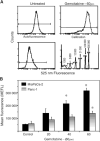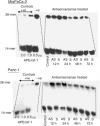Effects of gemcitabine on APE/ref-1 endonuclease activity in pancreatic cancer cells, and the therapeutic potential of antisense oligonucleotides
- PMID: 15316562
- PMCID: PMC2747714
- DOI: 10.1038/sj.bjc.6602080
Effects of gemcitabine on APE/ref-1 endonuclease activity in pancreatic cancer cells, and the therapeutic potential of antisense oligonucleotides
Abstract
Apurinic/apyrimidinic endonuclease (APE) is a key enzyme involved in DNA base excision repair (BER) that is often expressed at elevated levels in human cancers. Pancreatic cancer cells treated with the nucleoside analogue gemcitabine (2', 2'-difluoro-2'deoxycytidine) showed increases in APE/redox effector factor (ref-1) protein levels (approximately two-fold for Panc-1 and six-fold for MiaPaCa-2), with corresponding increases in endonuclease activity. These results suggested that the activation of APE/ref-1 might be an adaptive response that contributes to gemcitabine resistance by facilitating BER. To test this hypothesis, we examined the effects of disrupting APE/ref-1 using antisense on gemcitabine toxicity. Antisense oligonucleotides decreased protein levels three-fold in MiaPaCa-2 and five-fold in Panc-1 in comparison to controls, associated with reduced endonuclease activity. Combination treatments with antisense oligonucleotides and gemcitabine partially suppressed the increase in APE/ref-1 activity seen in cells exposed to gemcitabine alone. While clonogenic assays showed only slight decreases in colony formation in cells treated with either antisense oligonucleotides or gemcitabine alone, the combination with APE/ref-1 antisense resulted in a 2-log enhancement of gemcitabine toxicity in Panc-1 cells. Overall these findings suggest that APE/ref-1 plays a significant role in gemcitabine resistance in some pancreatic cancer cells, and support the further investigation of novel treatments that target this protein.
Figures







Similar articles
-
Apurinic/apyrimidinic endonuclease-1 protein level is associated with the cytotoxicity of L-configuration deoxycytidine analogs (troxacitabine and beta-L-2',3'-dideoxy-2',3'-didehydro-5-fluorocytidine) but not D-configuration deoxycytidine analogs (gemcitabine and beta-D-arabinofuranosylcytosine).Mol Pharmacol. 2006 May;69(5):1607-14. doi: 10.1124/mol.105.021527. Epub 2006 Feb 15. Mol Pharmacol. 2006. PMID: 16481390
-
Small interfering RNA against the apurinic or apyrimidinic endonuclease enhances the sensitivity of human pancreatic cancer cells to gemcitabine in vitro.J Dig Dis. 2010 Aug;11(4):224-30. doi: 10.1111/j.1751-2980.2010.00442.x. J Dig Dis. 2010. PMID: 20649735
-
Anticancer clinical utility of the apurinic/apyrimidinic endonuclease/redox factor-1 (APE/Ref-1).Chin J Cancer. 2010 Mar;29(3):333-9. doi: 10.5732/cjc.009.10285. Chin J Cancer. 2010. PMID: 20193121 Review.
-
Alterations in the expression of the apurinic/apyrimidinic endonuclease-1/redox factor-1 (APE/Ref-1) in human melanoma and identification of the therapeutic potential of resveratrol as an APE/Ref-1 inhibitor.Mol Cancer Ther. 2005 Dec;4(12):1923-35. doi: 10.1158/1535-7163.MCT-05-0229. Mol Cancer Ther. 2005. PMID: 16373707
-
APE/Ref-1 and the mammalian response to genotoxic stress.Toxicology. 2003 Nov 15;193(1-2):67-78. doi: 10.1016/s0300-483x(03)00290-7. Toxicology. 2003. PMID: 14599768 Review.
Cited by
-
DNA repair proteins as molecular targets for cancer therapeutics.Anticancer Agents Med Chem. 2008 May;8(4):417-25. doi: 10.2174/187152008784220294. Anticancer Agents Med Chem. 2008. PMID: 18473726 Free PMC article. Review.
-
Reduced expression of DNA repair and redox signaling protein APE1/Ref-1 impairs human pancreatic cancer cell survival, proliferation, and cell cycle progression.Cancer Invest. 2010 Nov;28(9):885-95. doi: 10.3109/07357907.2010.512816. Cancer Invest. 2010. PMID: 20919954 Free PMC article.
-
APE1/Ref-1 role in redox signaling: translational applications of targeting the redox function of the DNA repair/redox protein APE1/Ref-1.Curr Mol Pharmacol. 2012 Jan;5(1):36-53. doi: 10.2174/1874467211205010036. Curr Mol Pharmacol. 2012. PMID: 22122463 Free PMC article. Review.
-
Isolation of a small molecule inhibitor of DNA base excision repair.Nucleic Acids Res. 2005 Aug 19;33(15):4711-24. doi: 10.1093/nar/gki781. Print 2005. Nucleic Acids Res. 2005. PMID: 16113242 Free PMC article.
-
Single cell trapping and DNA damage analysis using microwell arrays.Proc Natl Acad Sci U S A. 2010 Jun 1;107(22):10008-13. doi: 10.1073/pnas.1004056107. Epub 2010 May 13. Proc Natl Acad Sci U S A. 2010. PMID: 20534572 Free PMC article.
References
-
- Abbruzzese JL (2002) Past and present treatment of pancreatic adenocarcinoma: chemotherapy as a standard treatment modality. Semin Oncol 29: 2–8 - PubMed
-
- Arlt A, Gehrz A, Muerkoster S, Vorndamm J, Kruse ML, Folsch UR, Schafer H (2003) Role of NF-kappaB and Akt/PI3K in the resistance of pancreatic carcinoma cell lines against gemcitabine-induced cell death. Oncogene 22: 3243–3251 - PubMed
-
- Arrigo AP (1999) Gene expression and the thiol redox state. Free Radic Biol Med 27: 936–944 - PubMed
Publication types
MeSH terms
Substances
LinkOut - more resources
Full Text Sources
Other Literature Sources
Research Materials
Miscellaneous

